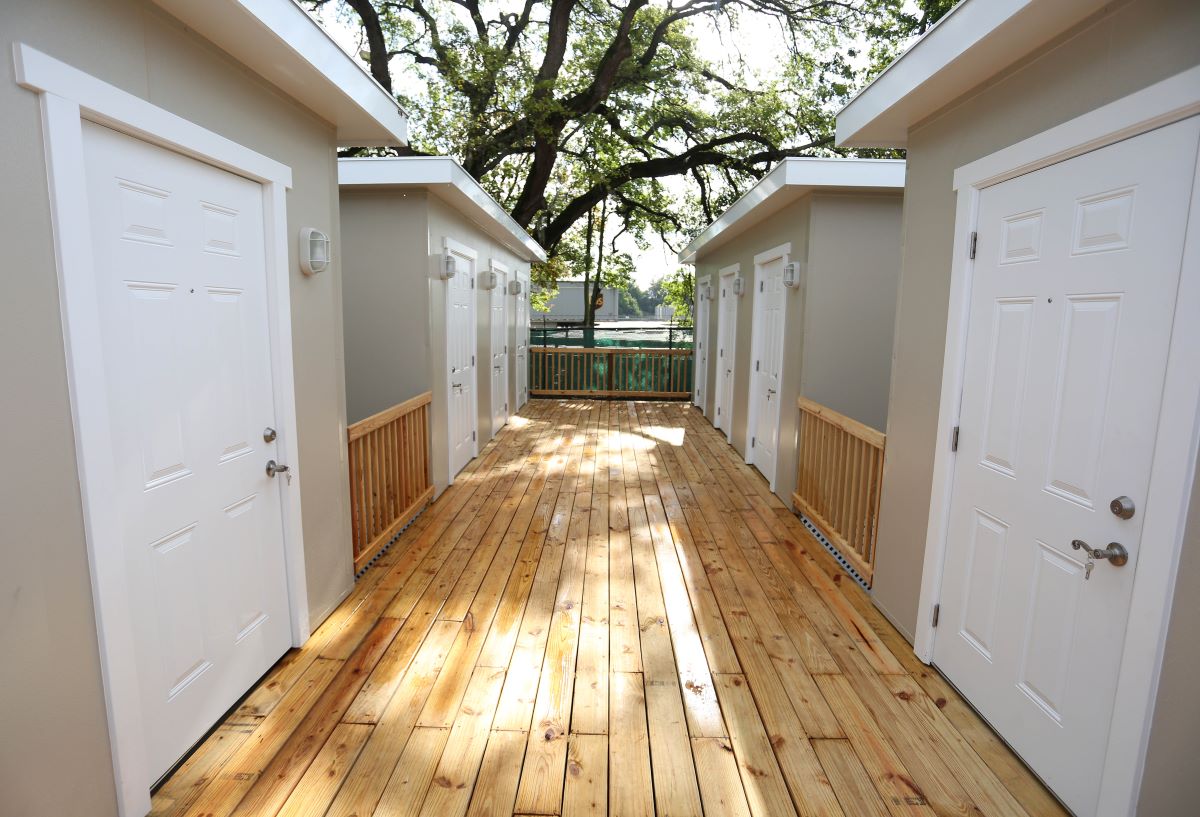Prioritizing Temporary Solutions to Homelessness, Such as Tiny Shed-Like Structures and Run-Down Makeshift Emergency Shelters, is Bad for Business and the Environment
Homelessness is creeping up all around us, the result of multiple avenues of turmoil intersecting. Here is where the housing crisis meets the drug epidemic, where a lack of healthcare collides with a lack of affordable rental units, where poverty levels dip and car engines die as the impact of inflation makes living in vehicles a luxury some people can’t afford.
Homelessness is undoubtedly an emergency situation. However, it’s not one that just recently crept up.
According to the National Library of Medicine, vagrancy has been a national issue dating back to the 1870s, meaning we’ve gone centuries without resolving it.
Turning to short-term solutions as an emergency response is understandable and, in some situations, even necessary. But prioritizing short-term solutions over long-term, non-punitive approaches to homelessness just creates a new mess and one that is likely being dumped into your local landfill.
Pallet Shelters: A Proposed Short-Term Solution with Long-term Environmental Implications
Tiny houses are a trendy, albeit minimalistic way to live. BBC Culture has called them “an architectural and social movement,” a kind of revolution in home design.
One thing that makes the tiny house lifestyle so appealing is the element of sustainability. Living smaller can mean simultaneously lowering your carbon footprint and mortgage payment, a win-win for thrifty spenders and environmental enthusiasts.
But what happens when a cultural movement shifts and becomes the polar opposite of the revolution it’s supposed to represent?
If a tiny home is no longer sustainable and actually posing an environmental threat, does that mean it is defeating its own purpose? This is the question we need to be asking when self-titled “tiny homes” are presented as a temporary solution to the homeless crisis.
When society suddenly goes from taking innovative artistic approaches to architecture to salvage environmental elements and then transitions to warehousing human beings in shed-like structures that are environmentally hazardous, everything else is a slippery slope.
Here’s why.
Pallet Shelters Are Not the Same as Tiny Houses
Between 2019 and 2020, Pallet Shelter sales increased by a jaw-dropping 7,000%. Politicians are progressively pushing them as transitional housing for unsheltered individuals and families. Still, these structures might not be what you think they are.
As the name denotes, the pallet shelter is a structure designed to shelter, not house. As such, the tiny house contains a myriad of basic necessities that are generally unavailable for pallet shelter dwellers.
Essential things like running toilets, Wi-Fi setups, and electricity, for example, do not come standard with the pallet shelter models. Features like heat, air conditioning, electricity, and interior lighting are listed as optional add-ons, which speaks volumes about the ominous conditions pallet shelter residents will likely be exposed to. It also says a great deal about the environmental impact of dotting our landscape with overcrowded scrap metal sheds.
Former Executive Director of the United States Interagency Council on Homelessness Barbara J. Poppe has pointed out that many of the models offering an optional electrical connectivity kit are doing so at the risk of the people living inside.
“They don’t even have clear power,” she explained, describing some electrical units as being hotwired off telephone poles, which could contribute to these units catching fire on multiple occasions.
Fire concerns abound when it comes to pallet shelter villages where up to two people are crammed into a 64-square-foot space and forced to “live.” Will they even survive? Orange County Fire Marshal Lauren Andrade says that having the units filled to this capacity will put out a lot of BTUs, causing fires to spread faster.
Several models have already gone up in flames, so it’s important to note that these (and, for that matter, all) house fires are environmentally destructive.
During a house fire, the carbon emissions the fire releases combine with any toxins released by burning possessions to create a polluted, smoky atmosphere. And while all that is going up in smoke, it’s driving contaminated water to the ground sending ash and debris from the ends of firefighters’ hoses deep down into the storm drains of the community.
These factors should be considered whenever highly flammable villages are intentionally constructed across the country.
Pallet Shelters Are Not Equipped with Bathrooms
As a general rule of thumb, pallet shelters are never fitted with bathrooms, meaning that pallet shelter villages would sport the same communal bathrooms that city officials already complain about seeing in homeless encampments. This is a rather odd scenario, given the lengths that cities have gone to point out the environmental hazards of human waste whenever the topic of homeless encampment sanitation is mentioned.
Makeshift, portable, communal bathrooms are presented as unhygienic and environmentally unfriendly until they wind up in the middle of a pallet shelter village. Then, we are told they are okay or even helpful. As if to say that human waste is only hazardous when the government isn’t regulating it.
This kind of thinking deserves to be flushed, literally.
Pallet Shelters are Supposed to be Temporary, but They’re Designed to Last for Decades. How is This a Sustainable Model?
Pallet shelters were made popular during the pandemic as a temporary solution to homelessness. Supporters claim they were designed to make the transition from homelessness to housing more comfortable than an underpass.
The shelters can be put together quickly, requiring little to no tools and under an hour’s worth of construction time. Yet, although they are presented as temporary, they’re designed to last for years, decades even, which poses some serious environmental threats.
Let’s consider, for a moment, the construction of these contraptions. Pallet shelters are comprised of aluminum framing, which is, at best, a controversial building material in terms of sustainability. Aluminum does have its share of supporters raving about how green it is, but not everybody agrees with this stance.
Napier University School of Engineering identified aluminum as the most environmentally harmful construction material on earth. To quote Continuing Education, “UK study, ‘Life Cycle Analysis of Window Materials’ concluded that aluminum window frames cause the highest environmental impact because of dangerous pollutants released and high energy consumption during production.”
Reuters writer Andy Home explains the inconsistency, stating that aluminum sports a “split eco-personality” because it is “green in its applications” but also “a lot darker in its production”.
Simply put, the lightweight metal requires tons of energy when it’s being manufactured but then makes up for that heavy carbon footprint by being easy to recycle.
With this understanding in mind, we can conclude that aluminum framing is better for the environment when it’s being recycled and worse for the environment when it’s being manufactured.
With a whopping 7,000% growth in sales, it’s pretty safe to assume that pallet shelters are being manufactured much faster than they are being recycled. Furthermore, if these structures are being built all over the country with warranties that last up to ten years, isn’t this basically a subliminal admission that homelessness isn’t going anywhere anytime soon?
Pidgeon-Holed into a Future Where More Homelessness Exists
At the rate that we are building “temporary shelter villages,” it won’t be long before they dot the streets of various cities nationwide, threatening the future with a landscape where the average “home” is smaller than the coffin homes of Hong Kong. For the record, these pallet shelters are, in many cases, smaller than Hong Kong’s notorious coffin homes, which journalists have referred to as “anything but fortunate” for the people living inside them. To be precise, the average coffin home is about 120 square feet, while the average pallet shelter is nearly half that, at 64 square feet.
Incidentally, even modern prison cells have a minimum space requirement of 70 square feet for inmates. And we all see what happened when they built a bunch of prison cells this size. They filled them to capacity. To that end, what happens, here in the U.S. in ten years, when there is a surplus of prison-sized shelters with nobody inside them and the rent’s too high for the average-income earner to pay? Who do you presume will be living there then?
To recap, according to lawmakers, here’s the current plan to fix climate change and restore humanity:
- We keep homelessness even though it’s known to cause premature death and contribute to environmental hazards.
- We keep blight — those dilapidated and foreclosed houses that outnumber the people who need houses. We don’t fix those. We just leave them right where they are to fill the air with permeated mold and rotten debris and contaminate the groundwater with pipes that will never be fixed.
- Then, we sweep the homeless encampments taking non-biodegradable tents that were saving people’s lives and chucking them right into landfills where they’ll never break down.
- As our final mode of climate action, we line the countryside with dystopian shelter villages comprised of flammable tiny aluminum sheds with no toilets and a construction material lifespan exceeding ten years.
This is what we’re up against. These are the policies that get passed in your silence.
Please Talk to Your Representatives About Prioritizing Housing Over Temporary Shelter
Isn’t one of the main reasons we’re building these temporary shelters allegedly the fact that street homelessness is bad for the environment? Yet, these shelter villages promote almost the same exact things:
- a lack of sanitation and bathrooms
- poor, faulty, or non-existent electrical wiring
- an affinity for catching on fire
- increased risk for infectious disease due to overcrowding
- air and water pollution, and the very real possibility of creating, or at least sustaining
- even more homelessness in the future
Urge your lawmakers to take a stand for the planet and the people who live here by prioritizing housing over temporary shelter and making housing a human right.












